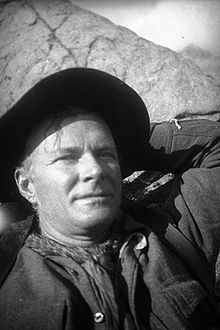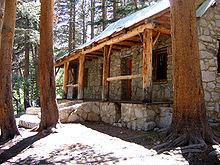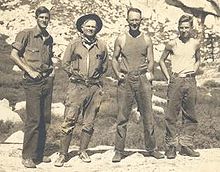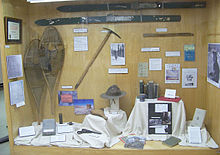- Norman Clyde
-
Norman Clyde 
Norman Clyde in the Sierra Nevada in 1931Born April 8, 1885
Philadelphia, PennsylvaniaDied December 23, 1972 (aged 87)
Bishop, CaliforniaResting place Norman Clyde Peak
37°04′30″N 118°28′22″W / 37.075°N 118.47278°WKnown for Mountaineering first ascents in the Sierra Nevada Norman Clyde (April 8, 1885–December 23, 1972) was a mountaineer, mountain guide, freelance writer, nature photographer, and self trained naturalist. He is well-known for achieving over 130 first ascents, many in California's Sierra Nevada and Montana's Glacier National Park. He also set a speed climbing record on California's Mount Shasta in 1923.[1] The Bancroft Library at the University of California, Berkeley has 1467 articles written by Clyde in its archives.[2]
Contents
Early life, marriage and work
Clyde was born in Philadelphia, the son of a Presbyterian minister. He attended Geneva College graduating in the Classics in June 1909. After teaching at several rural schools, including Fargo, North Dakota and Mount Pleasant, Utah, he enrolled at the University of California, Berkeley in 1911. After two years of graduate work he returned to teaching, mostly in northern California, including the towns of McCloud and Weaverville. He taught history, science and Latin. He continued graduate studies at the University of California in Berkeley in 1923 - 1924.
On June 15, 1915, Norman Clyde married Winifred May Bolster in Pasadena, California. She was a nurse at a tuberculosis hospital, and contracted the disease herself at approximately the time of their marriage. After 4 years of suffering she died at age 28 in 1919. His wife's death appears to have profoundly affected him as he moved to the Eastern Sierra to spend much of his latter life alone in the mountains.
He became principal of the high school at Independence, California in 1924, but resigned in 1928. He admitted firing a pistol during a confrontation with some students who allegedly came to vandalize the school on Halloween night. One bullet hit the side of a car carrying eight high school students, but there were no injuries. Clyde said that considerable damage had been done to the school grounds the previous Halloween. He had been issued a license to carry a concealed firearm on February 2, 1928. This was the end of his career as a schoolteacher and principal, as he resigned in exchange for an agreement by the District Attorney not to press charges.[3]
Subsequently he spent his winters as the caretaker of the local lodges, including Glacier Lodge on Big Pine Creek, and a fishing cabin which belonged to Lon Chaney, Sr. He earned some sporadic income as a mountain guide and freelance writer.
Life in the mountains
Clyde began climbing in the Sierra Nevada in 1910, when he visited Yosemite and Sequoia National Parks, writing to his mother that "I climbed the highest mountains in the region". He also visited McCloud, CA near Mount Shasta that summer. He began a regimented program of mountaineering in the Sierra Nevada in 1914, including the first of his first ascents. He also joined the Sierra Club in 1914. He first climbed Mount Shasta in 1916, and climbed that peak a total of 12 times. While living in Southern California during his wife's illness, he climbed Mount San Jacinto in 1917. Following his wife's death in 1919, he climbed extensively in the Kings-Kern Divide region of the southern Sierra.
In 1920, Clyde journeyed with a Sierra Club group from Yosemite Valley to the Evolution Basin, completing many climbs along the way. He set a speed climbing record on Mount Shasta in 1923, ascending from Horse Camp at approximately 8000' to the summit at 14,162' in 3 hours and 17 minutes. That year, he also spent 36 days in Glacier National Park, MT, where he climbed 36 mountains, including 11 first ascents. The National Park Service issued a press release praising his accomplishments in Glacier National Park. He returned to climb in Glacier National Park in 1924 and 1937.
In 1925, he completed 53 climbs in the Sierra Nevada, and told Francis Farquhar that "I sometimes think I climbed enough peaks this summer to render me a candidate for a padded cell--at least some people look at the matter in that way. However, I get a lot of enjoyment from this rather strenuous form of diversion." In 1926, he climbed in Yellowstone National Park , Grand Teton National Park , the Beartooth Mountains and Absaroka Range of Montana, and the Sawtooth Range of Idaho. He made several additional first ascents in California that year.
In 1928, he was a leader of the High Trip to the Canadian Rockies organized by the Sierra Club, the Mazamas of Oregon, and The Mountaineers of the State of Washington. During this trip, he encountered professional mountain guides, and probably decided on this as his own career path. He spent six weeks traversing the San Gabriels of Southern California, probably in 1929. In 1930, he wrote an article describing his trip from the summit of Mount Whitney to the lowest point in Death Valley between sunrise and sunset.
Clyde's first published works appeared as a series of articles entitled "Close Ups of the High Sierra" in 1928, in the Automobile Club of Southern California's magazine, Touring Topics, and were later republished as a perfect-bound edition in 1962 by La Siesta Press (Glendale, CA), edited by Walt Wheelock.
1931 was a seminal year in the history of mountaineering in the Sierra Nevada, and Norman Clyde was in the midst of it. Sierra Club leader Francis P. Farquhar invited Harvard philosophy professor and Appalachian Mountain Club member Robert L. M. Underhill to come to the Sierra Nevada to teach the latest techniques of roped climbing. Underhill had learned these techniques in the Alps, and had practiced them himself earlier that summer in the Tetons and the Canadian Rockies. After some young climbers were instructed in the techniques, a group including Clyde, Jules Eichorn, Lewis Clark, Bestor Robinson and Glen Dawson traveled south to the Palisades, the most rugged and alpine part of the Sierra Nevada. There, on August 13, 1931, the party completed the first ascent of the last unclimbed 14,000+ foot peak in California, which remained unnamed due to its remote location above the Palisade Glaciers. After a challenging ascent to the summit, the climbers were caught in an intense lightning storm, and Eichorn barely escaped electrocution when "a thunderbolt whizzed right by my ear". The mountain was named Thunderbolt Peak to commemorate that close call.
Three days later on August 16, Eichorn, Clyde, Underhill and Dawson completed the first ascent of the East Face of Mount Whitney, the highest peak in the contiguous United States.[4] The route was extremely exposed, especially the famous Fresh Air Traverse. Steve Roper called this route "one of the classic routes of the Sierra, partly because of its spectacular location and partly because it was the first really big wall to be climbed in the range."[5] Porcella & Burns wrote that "the climb heralded a new standard of technical competence in Californian rock climbing..."[6] These events led to a lifelong friendship between Clyde and Jules Eichorn.
In 1932, he climbed El Picacho del Diablo in Baja California, Mexico, and climbed it again in 1937. He met David Brower in the Sierra Nevada in 1933, and in 1934 spent time with Brower and Hervey Voge as the younger men bagged 32 first ascents in ten weeks traveling through the High Sierra. From June 23–26, the trio climbed 10 of the 12 major pinnacles of the Devils Crags.
He served as climbing leader on many Sierra Club sponsored High Trips where he became known as "the pack that walks like a man" because of the huge backpacks he carried. In addition to as many as five cameras, he carried a hammer and cobbler's anvil in order to make field repairs to client's boots. In 1931, Underhill wrote that Clyde's backpack was an "especially picturesque enormity of skyscraper architecture".[7] Clyde was also well-known for wearing a campaign hat.
Clyde led or participated in many mountain rescues and is credited with saving a number of lives. He also helped in many recoveries and is remembered for discovering Pete Starr's body in the Minarets, in 1933, after all other searchers gave up. Clyde later returned to the site with Jules Eichorn, and they buried Starr's body where Clyde had found it on Michael Minaret.[8][9]
Norman Clyde still guided parties into the Sierra into the 1960s, when he was in his seventies. In the 1950s and 1960s, he lived by himself at the old Baker ranch-house on Baker Creek near Big Pine. Because he was trained in the classics, Norman Clyde loved to read books in Latin and Greek. At the Baker ranch-house, Clyde had thousands of rare classical books. At age 80, he was still sleeping outside the ranch-house on a mattress and sleeping bag, as long as it was fair weather. In the spring of 1968, he transferred to a skilled nursing facility in Bishop where he could receive adequate care. In 1969, his cancerous left eye was removed. He died in Bishop on December 23, 1972 at age 87, surrounded by the high peaks of the Sierra Nevada that he loved so much. The cause of death was "metastatic melanoma - primary in eye."
Legacy
Norman Clyde received an honorary Doctor of Science degree from his alma mater, Geneva College, in 1939. He received the college's Distinguished Service Award in 1962.
In 1947, the Sierra Club Handbook praised Clyde's mountaineering accomplishments: "Outstanding among members who have helped others gain mountain experience is Norman Clyde, whose amazing achievements in scaling practically all the peaks in the High Sierra are well known to mountaineers. More than one climber has exulted in a supposedly first ascent, only to find later that Clyde went up that 'unclimbed peak' in the winter of, say, 1920! There are many seasoned climbers who can look back on their early days as novices in the mountains and remember with gratitude what they learned from Clyde".[10]
Jointly with Allen Steck, he was the first recipient of the Sierra Club's Francis P. Farquhar Mountaineering Award in 1970.[11]
Clyde Minaret, Clyde's Ledge, Clyde's Meadow along the Mountaineer's Route on Mt. Whitney, and Norman Clyde Peak bear his name. His ashes were scattered from Norman Clyde Peak by Smoke Blanchard, his son Bob Blanchard and a party that included Jules Eichorn.
The Eastern California Museum in Independence has an extensive collection of memorabilia, documents and photos pertaining to Clyde's life on display. In the Wall Street Journal, Michael J. Ybarra described this exhibit as "absorbing".[12]
Norman Clyde's life and mountaineering achievements were originally documented in the book, Close Ups of the High Sierra, published by La Siesta Press (Glendale, CA) in 1962. In 1998 Spotted Dog Press published an expanded edition of the book, Norman Clyde: Close Up of the High Sierra,[13] edited by Wynne Benti. The foreword for the 1998 edition of Close Ups of the High Sierra included a brief biography on Clyde, written by Benti, and was the first time in history that any in-depth information was published about Clyde's wife, Winifred Bolster.
Clyde's life and mountaineering achievements were later documented in a biography written by Robert C. Pavlik and published in 2008.[14]
References
- ^ Eichorn, Arthur Francis, Sr. (1954). Record Ascents and the 1925 Marathon. Mount Shasta Herald. http://www.siskiyous.edu/shasta/out/cli/rec1.htm. Retrieved 2008-02-25.
- ^ "Norman Clyde Papers". The Bancroft Library. BANC MSS 79/33 c. http://content.cdlib.org/view?docId=tf996nb44j&doc.view=entire_text. Retrieved 2008-11-06.
- ^ "Speeding Bullet Ends Boy Frolic on Hallowe'en". Inyo Independent LIX (32). November 3, 1928.
- ^ Roper, Steve; Allen Steck (1979). Fifty Classic Climbs of North America. San Francisco: Sierra Club Books. pp. 276–282. ISBN 0-87156-292-8.
- ^ Roper, Steve (1976). The Climber's Guide to the High Sierra. San Francisco: Sierra Club Books. ISBN 0-87156-147-6.
- ^ Porcella, Stephen P.; Burns, Cameron M. (1998). Climbing California's Fourteeners: 183 Routes to the Fifteen Highest Peaks. Seattle: The Mountaineers. ISBN 0-89886-555-7.
- ^ Roper, Steve; photographs by David Stark Wilson (2008). "The Whitney Region". Above All: Mount Whitney + California's Highest Peaks. photographs by David Stark Wilson. Berkeley: Yosemite Association and Heyday Books. ISBN 978-1-59714-107-9.
- ^ Secor, R. J. (May 1999). The High Sierra, Peaks, Passes, and Trails. Mountaineers Books. ISBN 0-89886-625-1.
- ^ Alsup, William (February 2001). Missing in the Minarets, the search for Walter A. Starr, Jr.. Yosemite National Park: Yosemite Association. ISBN 1-930238-08-8.
- ^ Parsons, Harriet; David A. Brower, editor (November, 1947). "The Sierra Club: A Handbook". Sierra Club Bulletin (San Francisco: Sierra Club) 32 (10): 17–18.
- ^ "List by Award". Sierra Club Awards. http://www.sierraclub.org/awards/downloads/award_sr.pdf. Retrieved 2011-06-02.
- ^ Ybarra, Michael J. (September 10, 2009). "A Solitary, Singular Life". Wall Street Journal. http://online.wsj.com/article/SB10001424052970203863204574345003001544422.html. Retrieved September 16, 2009.
- ^ Benti, Wynne (1998). Norman Clyde: Close Ups of the High Sierra. Bishop, CA: Spotted Dog Press, Inc.. ISBN 0-9647530-3-0.
- ^ Pavlik, Robert C. (2008). Norman Clyde: Legendary Mountaineer of California's Sierra Nevada. Berkeley: Heyday Books. ISBN 978-1-59714-110-0.
Bibliography
- Clyde, Norman (1971). Norman Clyde of the Sierra Nevada; Rambles Through the Range of Light. Scrimshaw Press. ISBN 0-912020-19-9.
External links
- Galic, Hrvoje. "Lonely Grave in the Sierra". http://www.stanford.edu/~galic/rettenbacher/clyde.html. Retrieved 2008-02-25.
- Alsup, William. "The Search for Peter Starr". http://www.traditionalmountaineering.org/News_PeterStarr.htm. Retrieved 2008-02-25.
- Guide to the Norman Clyde Papers at The Bancroft Library
 Media related to Norman Clyde at Wikimedia CommonsCategories:
Media related to Norman Clyde at Wikimedia CommonsCategories:- 1885 births
- 1972 deaths
- Sierra Club
- American mountain climbers
- Sierra Nevada (U.S.)
- Geneva College alumni
Wikimedia Foundation. 2010.



